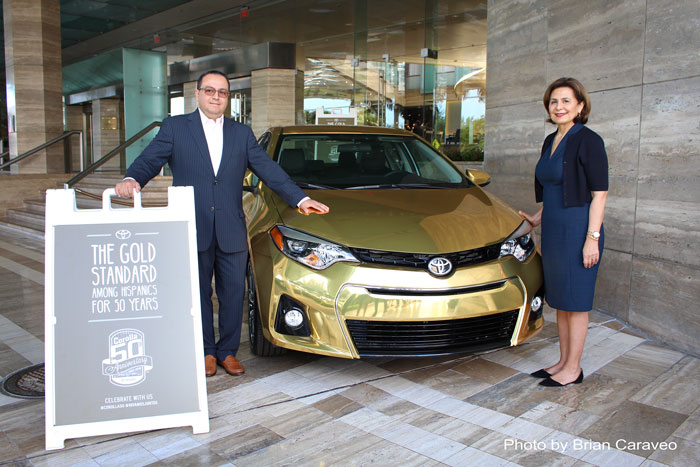

A Most Interesting Year
In downtown Miami in April, Toyota’s Patricia Salas Pineda and Luis Rosero posed for photos with the guest of honor at a 50th anniversary party unlike any other. The Toyota Corolla compact sedan was celebrating a golden milestone and its undisputed standing as the world’s best-selling car of all time.
The setting was Hispanicize 2016 and Toyota’s return for a third consecutive year as the automotive and transportation sponsor of the country’s largest gathering of Hispanic social and digital media influencers. It was a fitting occasion given Hispanics’ love affair with the Corolla over several decades.
According to IHS Automotive’s Polk Market Data unit, U.S. Hispanics spent $44 billion on new vehicles and outpaced all other consumer segments as drivers of sales growth. Toyota as a brand has enjoyed sustained leadership for more than a decade as the preferred nameplate of Hispanic new car buyers. For the year ending December 2015, IHS reported that U.S. Hispanics comprised a 17.7% share of overall Toyota brand sales. And, the Corolla is the jewel in the Toyota crown with a 27% share of the brand propelled by sales to Hispanic consumers who bought more than one out of four new Corollas sold in the U.S.
Pineda is group vice president and Rosero is director of Toyota’s Hispanic Business Strategy Group (HBSG), an industry-leading approach to bolstering the company’s existing ties to the Latino community for the Toyota, Lexus and Scion brands. Throughout 2016, they will be touting the Corolla legacy and its special relationship with Hispanic families across generations.
“As we travel the country engaging with community partners, dealers, elected officials and the media in the Latino community, we will collect and share authentic stories about how the Corolla has played a part in people’s lives,” explained Pineda, Toyota’s highest-ranking Hispanic executive.
The many memories and miles travelled throughout Corolla’s half century will come to life via Recorriendo Historias activations at Hispanic-focused events. At Hispanicize, the company implemented the theme by displaying a current model alongside one wrapped in white canvas where attendees drew artistic representations of their experiences with the Corolla. An interactive video and photo kiosk invited participants to record and post their personal stories on social media. A Corolla wrapped in gold film was the lead vehicle in a ride-and-drive experience to a scenic beachfront café where journalists and bloggers were treated to a Corolla-shaped birthday cake and a trivia game highlighting the evolution of the vehicle across the decades.
“Through our first-hand interaction with Hispanic consumers across the country, we have heard so many amazing Corolla owner and passenger stories – from family road trips, to first dates, to marriage proposals,” commented Rosero. “Behind these stories has been multi-generation brand loyalty largely based on high-quality, reliable and economical vehicles that meet the lifestyle needs of U.S. Hispanics.”
Pineda, a Mexican-American born in California, recalled her own Corolla story: “My second car was a Corolla SR5 I bought me when I started law school at the University of California at Berkeley.” A few years after graduation, Pineda would find herself heading up legal, environmental affairs and human resources at the Fremont, California, manufacturing plant rolling out the first American-made Corollas in a joint venture with General Motors formed in 1984. In North America today, Toyota builds Corollas in Mississippi and Canada.
The Corolla was “born” in 1966 in Japan and officially came to the U.S. in 1968. Its arrival intersects with the timeline of a burgeoning Hispanic market, which then comprised just four percent of the U.S. population but was poised to become a powerhouse. According to Pew Research Center, the Hispanic share of the U.S. population rose to 18% or 55.4 million over the last 50 years and accounts for the largest increment in overall population of any racial or ethnic group.
In the mid-to late 1960s, U.S. Latinos, barely nine million strong, were stepping up and actively engaging in the national conversation. Cesar Chavez’s United Farm Workers movement was calling for sweeping changes in civil rights and labor policy. In 1968, President Lyndon Johnson proclaimed national Hispanic Heritage Week (later expanded to a full month). The arrival of thousands of Cuban exiles would transform South Florida forever. Successive waves of migration from Latin America and the Caribbean gave birth to Spanish-language media outlets as conduits for reaching a vibrant and growing market.
“When Toyota started advertising in Spanish more than 25 years ago, we were among just a few brands that saw the market’s potential,” recalled Pineda. “We attribute our strong Latino ties largely to a sustained presence, strong relationships and trust forged over time.”
Rosero underscored the importance of strategic engagement with Hispanic consumers: “We believe that creating a Hispanic strategy is a must for any automaker selling cars in America if they want to stay relevant and succeed. We have no doubt that Latinos are the future.”
“Toyota’s being the number one automotive choice for Latinos did not happen overnight and it is a prized relationship we do not take for granted,” Pineda asserted. “The Corolla story is in many ways the narrative of Toyota’s relationship with the Hispanic community.” Throughout the year, the company will celebrate the affinity the Corolla has earned in the community and hold up drivers’ stories as a measure of success, she added.
The Toyota family tree includes 11 generations of Corollas and more than 43 million sold worldwide. The 50th anniversary special edition 2017 Corolla will hit the market this September in time for Hispanic Heritage Month. With new custom features and a redesigned interior, just 8,000 units will be sold in the U.S.
By Rosemary Ravinal